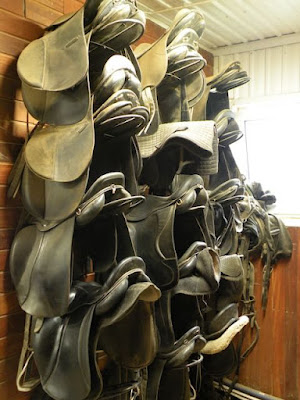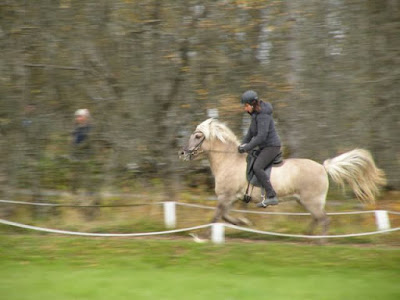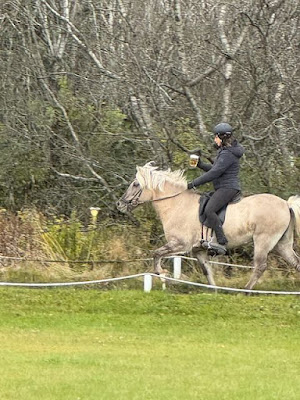According to Hubby, the highlight of today's bus tour would be the stop at Fridheimar where we got to see, pet and learn about the Icelandic Horses.
This lady was our hostler in all things about the horses on the farm. She shared Iceland has 400,000 people and 100,000 Icelandic horses. No other horses can be brought to Iceland because of possible disease. The Icelandic horse was introduced by the Vikings from Norway and Denmark and the animals have adapted to the terrain and climate of the island country over the 1000+ years.
25 of the 40 colors of the Icelandic horses
Like every group (of Americans, especially) who has ever come to tour the farm, the question was why aren't they called ponies because they are smaller than typical horses? Pony is not a word in the Icelandic vocabulary! Only horse is a word. Yes, their horses may be smaller, but they do vary in size.
This photo shows the white and brown horse is smaller in size than the middle horse. The horses are brought into the farm barns in the winter; not left out in the pastures on the farms. We rarely saw cows in the pastures as they have already been moved to the barn or barnyards for the winter. Sheep and horses were still grazing in the pastures along the highways we traveled, but they both will be moved inside before too long.
According to our hostler, the Icelandic horses are very gentle. They rarely kick but might bite if we held our hands cupped under their mouths. They would be expecting something to eat! Petting with a flat hand was encouraged.
So why are there so many horses in Iceland? On the farm we toured, the horses were trained for competitions. On some farms the horses are used for breeding. My research also said: each horse is given its own unique kennitala (national insurance or social security number) and Icelanders often use apps to keep track of their steed.
And in some cases, the horses are used for farm work, for pack and draft work, which are conformationally distinct from those bred for work under saddle, which are carefully selected for their ability to perform the traditional Icelandic gaits. Others are bred solely for horsemeat. Some breeders focus on favored coat colors. Our hostler mentioned they are used to herd the sheep in the fall and bring them into the barns.
We noticed signs along the road of farms offering horse riding, which is very popular. Many farms have horses simply for the family's pleasure.
So what makes an Icelandic horse different and special? Other breeds of horses have 3 gaits: walk, trot, gallop. Icelandic horses have 5 gaits: walk, trot, tôlt, gallop, and pace. The above poster has pictures of each gait at the bottom.
One of the trainers demonstrated each of the 5 positions.
The hostler gave her a full mug of beer and the horse galloped around the track. The rider's butt never moved out of the saddle.
She and her horse brought a full mug of beer back after the lap. This photo also is a good demonstration of the size of this horse as the hostler was a woman shorter than I. She also demonstrated the pace gait. We all agreed it was beautiful for the horse and rider.
We had an opportunity to visit with the rider after the demonstration. This horse is about 15 years old and has trouble moving from one gait to another, so she is rarely entered in competitions. Icelandic horses begin their training around age four.
Icelandic horse competition ONLY involves moving through the 5 gaits. There is no dressage or jumping competitions. There are Icelandic horses in many countries and competitions in many countries, especially Europe, but also in the US. Icelandic law prevents horses from being imported into the country and exported animals are not allowed to return.
And from Wikipedia:
Icelandic horses weigh between 330 and 380 kilograms (730 and 840 lb) and stand an average of 13 and 14 hands (52 and 56 inches, 132 and 142 cm) high, but the shortest measured Icelandic horse is 113cm (11.1hh) and the tallest measured at 157cm (15.3hh). which is often considered pony size, but breeders and breed registries always refer to Icelandics as horses.












No comments:
Post a Comment
Thanks for your comments!